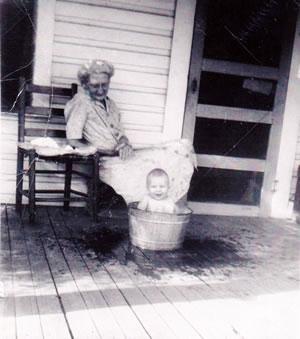 July 3, 2016 - I recently discovered an old photograph of my grandmother, Mary Murphy, on her front porch watching her grandson, Larry Woods, playing in a wash-tub filled with water. Both Mary and Larry are gone from us now, but the image of the porch stuck in my mind. I miss front porches on our homes.
July 3, 2016 - I recently discovered an old photograph of my grandmother, Mary Murphy, on her front porch watching her grandson, Larry Woods, playing in a wash-tub filled with water. Both Mary and Larry are gone from us now, but the image of the porch stuck in my mind. I miss front porches on our homes.
The front porch is almost unique to America, spanning the front of countless homes in every city and small town. Porches were wide or narrow, one story or two, cover half the front façade or wrap around three, or even all four sides.
Porches emerged beginning in the middle of the 19th century as cities grew larger and families began living in individual houses. Porches were a necessity before air conditioning, whether it was the screened sleeping porch, or the broad, columned veranda where iced tea and gossip were plentiful.
The front porch functioned as an important transitional space between the private world of the family and the public realm of the street. The heyday of the front porch lasted from the early 1880s to the middle 1920s. Families added front porches to their homes, or built new houses with elaborate porches. The porch became the comfortable spot for a summer evening where the whole family could relax after dinner. Neighbors taking an evening stroll could engage in conversation, or be invited up to visit.
Technology erased the front porch by the 1950s when radios, and later televisions in the living room, and automobiles in the driveway came to take us away for other entertainments. The front porch disappeared from house plans to be replaced by patios and decks in the privacy of the back yard.
I miss the typical front porch which would be at least five feet wide, with a wooden ceiling, often covered with breadboard. Rails surrounded the porch, usually built to match the rest of the house, whether it was lacy gingerbread or sturdy stucco knee walls. The porch floor would be tongue-and-grooved planks laid with a slight pitch to help water drain away from the house.
Furniture on the front porch could be utilitarian, such as leftover straight chairs from inside, or chairs made from wicker or bamboo, with or without cushions. Rocking chairs proved to be especially popular for whiling away summer evenings. But, the ultimate accessory was a porch swing, suspended on chains at one end of the porch, the perfect place to rock a child to sleep, or to get to know a high school sweetheart.
Some people say that a house without a front porch is boring. Today the pendulum is sweeping back in the other direction, and front porches are being added to existing homes, and once again appearing on new house plans. The porch has regained popularity today as a gathering place for family and friends, that is, whenever the weather allows.
Fortunately Claude Stephens is trying to bring back the front porch. By day, he is the education director at an arboretum in Louisville, Ky. By evening, he’s known as Crow Hollister, his “porch swing alias”. Mr. Stephens is founder of the Professional Porch Sitters Union Local 1339. The group doesn’t have a motto, just a suggestion: “Sit down a spell. That can wait.”
The Professional Porch Sitters Union is about not planning anything. Anybody can call a meeting at any time, and attendance is optional, according to Stephens. Stephens says that the motto of his Union is “Sitting on the porch: Not a place, but a state of mind”. There are now thousands of locals in all 50 states, and at least four countries.
Stephens thinks his idea of the union is taking off because Americans long for what the porch represents. “When you’re on your porch you’re part of your community. When you’re in your house you’re not”, he says.
So, perhaps the front porch is making a come-back. I hope so. While driving around our small city one will note many large, old homes with huge porches, however, I don’t see many people sitting on them any more. Hopefully this will change in time.









